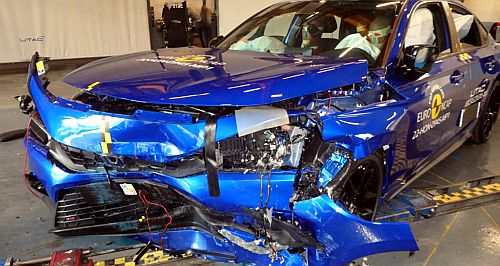Honda safety doesn’t measure up: ANCAP

POINTING to “inconsistent” safety equipment in the same model but different specification cars, the Australasian New Car Assessment Program (ANCAP) has given Honda a wrap over the knuckles “un-rating” the manufacturers petrol Civic model without crash testing it, while the Euro NCAP tested Civic e:HEV hybrid scores five stars.
The petrol-powered Civic is not sold in Europe so is not assessed by Euro NCAP.
ANCAP justifies its “criticism” of the petrol Civic in a statement saying it is built to and fitted with a considerably different safety specification to that of its hybrid sibling.
“The safety specification differences between hybrid and petrol Honda Civic variants include the omission of centre airbag – which helps protect against occupant-to-occupant and occupant-to-vehicle head injuries for front seat occupants, side thorax-protecting airbags for rear seat occupants – which help minimise rib and chest injury in side-impact crashes, speed sign recognition and intelligent speed limiter systems and intelligent seatbelt reminders for rear seating positions,” it said.
“As a result of these differences, ANCAP is unable to determine how petrol variants would likely perform when put through the suite of rigorous testing, leaving the present status of petrol Civic variants ‘unrated’.”
Also under a cloud is the Australian and New Zealand delivered Honda CR-V that ANCAP found lacking in sophisticated high tech safety equipment (ADAS) and the ZR-V that rates only four stars.
ANCAP testing and rating of the two medium size SUVs identified the CR-V as also having different safety specifications compared with its European sold counterpart.
“The CR-V sold in Australia and New Zealand have also been confirmed to hold a different safety specification to their European equivalents,” it continued.
Local CR-V vehicles are sold with a less-sophisticated suite of active collision avoidance (ADAS) features – Honda Sensing rather than the elevated Honda Sensing 360-degree camera system – putting the CR-V’s Safety Assist score beneath the five-star threshold at 68 per cent.
ANCAP explains the European delivered CR-V is offered with an optional ‘safety pack’ which sees the higher-spec vehicles achieve a five-star rating while those without the safety pack, a four-star rating.
The higher-performing Honda Sensing 360 system is not offered, even as an option, in vehicles sold to Australian and New Zealand consumers.
For the slightly smaller Honda ZR-V, the four-star rating for European-sold models has been confirmed for Australian models, however local vehicles are structurally different to their European siblings.
“A different front bumper beam is fitted to Australian vehicles, which affected test performance in some test impact locations. European vehicles are built with an additional beam in the rear doors, which is omitted from Australian-sold vehicles,” said ANCAP.
ANCAP says there’s no observable effect on test performance identified, but Honda is yet to provide information as to why the additional beam has been excluded.
The safety body’s European counterpart Euro NCAP last month awarded only a three-star safety rating for the new generation Suzuki Swift models specified for and sold into the European market.
Suzuki Australia has informed ANCAP that the safety specification of Swift vehicles sold in Australia and New Zealand is different to those sold in Europe but no testing of the locally delivered model has been carried out to date meaning a safety rating is unknown with ANCAP currently testing a locally supplied Swift to determine its safety performance.
Results from that assessment will be forthcoming shortly.
“What we’re seeing here are manufacturers consciously providing Australian and New Zealand consumers with products that do not match the same levels of safety provided to European consumers, and no doubt consumers will be surprised to learn of these differences,” said ANCAP chief executive officer Carla Hoorweg.
“We are seeing some manufacturers prioritise higher levels of safety only in markets where the regulation requires it – while others are offering different safety specifications based on the expectations of dominant sales markets, production locations, or markets with less mature consumer expectations.”
“While we do see this from time to time, we don’t want to see a more significant trend emerge.”
Government-enforced safety regulation has recently been enhanced for the European market with the introduction of EU General Safety Regulation (GSR2), while Australian regulation remains years behind in some areas.
“The lives and safety of Australian and New Zealand consumers are just as important as those in Europe or any other world region,” added Ms Hoorweg.
“That is why we continue to carefully examine new vehicles supplied locally and point out differences so consumers can make informed purchasing decisions.
“Any vehicle that is unrated is a potential candidate for testing by ANCAP,” she concluded.